steering wheel CADILLAC ESCALADE EXT 2005 2.G Owner's Guide
[x] Cancel search | Manufacturer: CADILLAC, Model Year: 2005, Model line: ESCALADE EXT, Model: CADILLAC ESCALADE EXT 2005 2.GPages: 460, PDF Size: 2.95 MB
Page 299 of 460
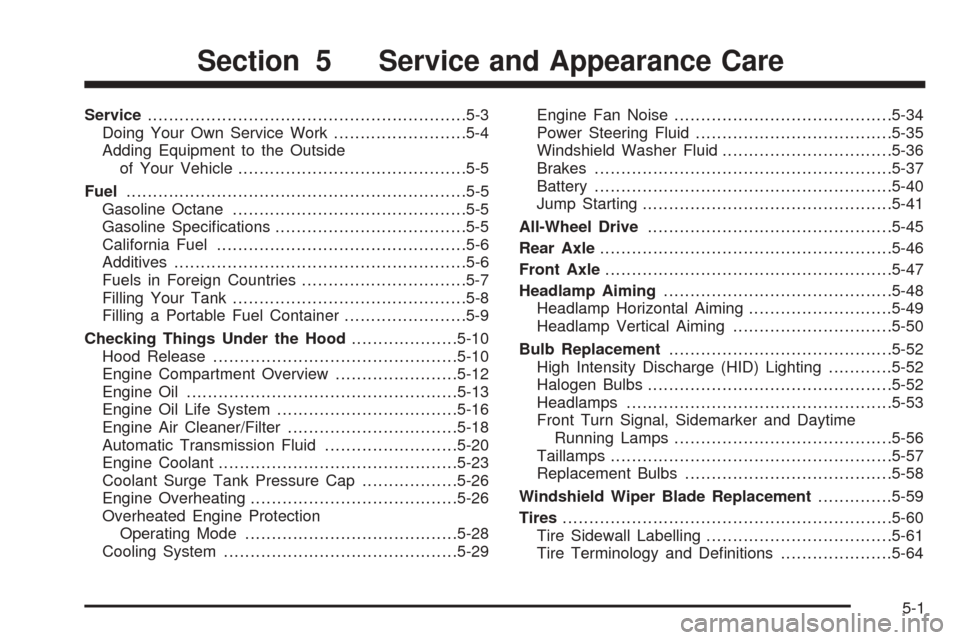
Service............................................................5-3
Doing Your Own Service Work.........................5-4
Adding Equipment to the Outside
of Your Vehicle...........................................5-5
Fuel................................................................5-5
Gasoline Octane............................................5-5
Gasoline Speci�cations....................................5-5
California Fuel...............................................5-6
Additives.......................................................5-6
Fuels in Foreign Countries...............................5-7
Filling Your Tank............................................5-8
Filling a Portable Fuel Container.......................5-9
Checking Things Under the Hood....................5-10
Hood Release..............................................5-10
Engine Compartment Overview.......................5-12
Engine Oil...................................................5-13
Engine Oil Life System..................................5-16
Engine Air Cleaner/Filter................................5-18
Automatic Transmission Fluid.........................5-20
Engine Coolant.............................................5-23
Coolant Surge Tank Pressure Cap..................5-26
Engine Overheating.......................................5-26
Overheated Engine Protection
Operating Mode........................................5-28
Cooling System............................................5-29Engine Fan Noise.........................................5-34
Power Steering Fluid.....................................5-35
Windshield Washer Fluid................................5-36
Brakes........................................................5-37
Battery........................................................5-40
Jump Starting...............................................5-41
All-Wheel Drive..............................................5-45
Rear Axle.......................................................5-46
Front Axle......................................................5-47
Headlamp Aiming...........................................5-48
Headlamp Horizontal Aiming...........................5-49
Headlamp Vertical Aiming..............................5-50
Bulb Replacement..........................................5-52
High Intensity Discharge (HID) Lighting............5-52
Halogen Bulbs..............................................5-52
Headlamps..................................................5-53
Front Turn Signal, Sidemarker and Daytime
Running Lamps.........................................5-56
Taillamps.....................................................5-57
Replacement Bulbs.......................................5-58
Windshield Wiper Blade Replacement..............5-59
Tires..............................................................5-60
Tire Sidewall Labelling...................................5-61
Tire Terminology and De�nitions.....................5-64
Section 5 Service and Appearance Care
5-1
Page 308 of 460
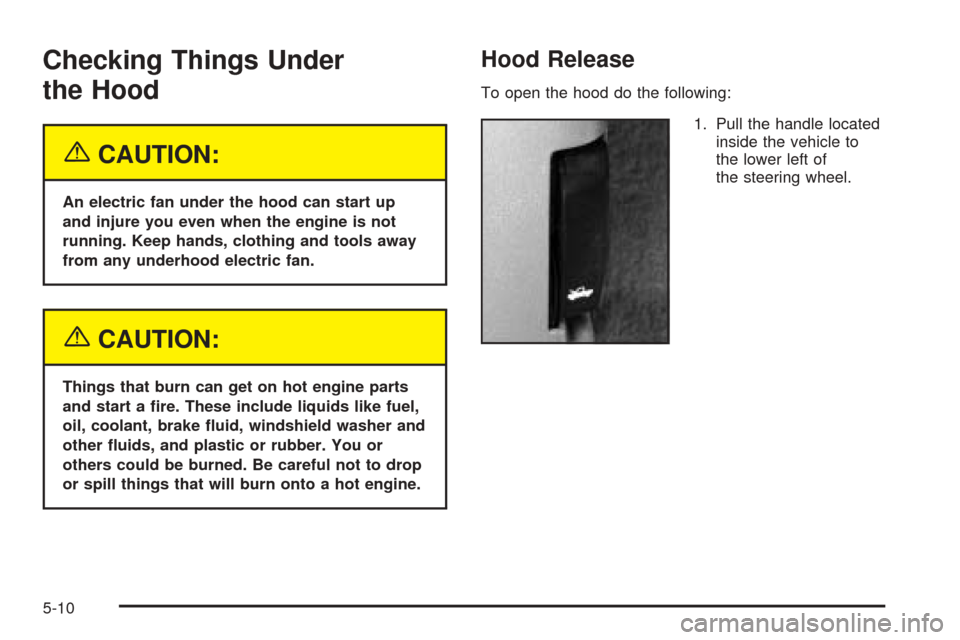
Checking Things Under
the Hood
{CAUTION:
An electric fan under the hood can start up
and injure you even when the engine is not
running. Keep hands, clothing and tools away
from any underhood electric fan.
{CAUTION:
Things that burn can get on hot engine parts
and start a �re. These include liquids like fuel,
oil, coolant, brake �uid, windshield washer and
other �uids, and plastic or rubber. You or
others could be burned. Be careful not to drop
or spill things that will burn onto a hot engine.
Hood Release
To open the hood do the following:
1. Pull the handle located
inside the vehicle to
the lower left of
the steering wheel.
5-10
Page 375 of 460
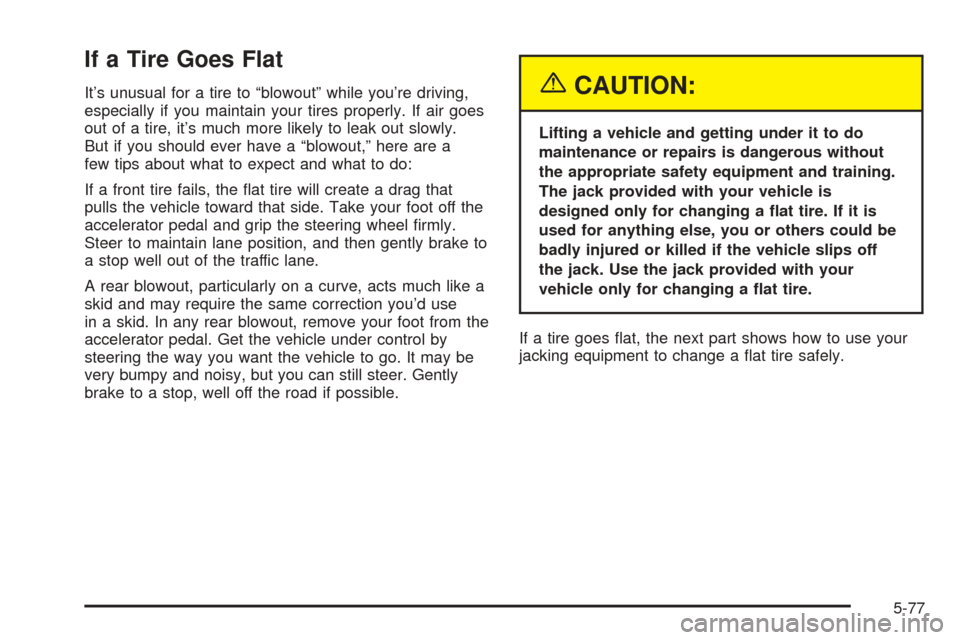
If a Tire Goes Flat
It’s unusual for a tire to “blowout” while you’re driving,
especially if you maintain your tires properly. If air goes
out of a tire, it’s much more likely to leak out slowly.
But if you should ever have a “blowout,” here are a
few tips about what to expect and what to do:
If a front tire fails, the �at tire will create a drag that
pulls the vehicle toward that side. Take your foot off the
accelerator pedal and grip the steering wheel �rmly.
Steer to maintain lane position, and then gently brake to
a stop well out of the traffic lane.
A rear blowout, particularly on a curve, acts much like a
skid and may require the same correction you’d use
in a skid. In any rear blowout, remove your foot from the
accelerator pedal. Get the vehicle under control by
steering the way you want the vehicle to go. It may be
very bumpy and noisy, but you can still steer. Gently
brake to a stop, well off the road if possible.{CAUTION:
Lifting a vehicle and getting under it to do
maintenance or repairs is dangerous without
the appropriate safety equipment and training.
The jack provided with your vehicle is
designed only for changing a �at tire. If it is
used for anything else, you or others could be
badly injured or killed if the vehicle slips off
the jack. Use the jack provided with your
vehicle only for changing a �at tire.
If a tire goes �at, the next part shows how to use your
jacking equipment to change a �at tire safely.
5-77
Page 442 of 460

General Motors reserves the right to unilaterally modify,
change or discontinue Courtesy Transportation at
any time and to resolve all questions of claim eligibility
pursuant to the terms and conditions described
herein at its sole discretion.
Vehicle Data Collection and Event
Data Recorders
Your vehicle, like other modern motor vehicles,
has a number of sophisticated computer systems that
monitor and control several aspects of the vehicle’s
performance. Your vehicle uses on-board vehicle
computers to monitor emission control components
to optimize fuel economy, to monitor conditions
for airbag deployment and, if so equipped, to
provide anti-lock braking and to help the driver
control the vehicle in difficult driving situations.
Some information may be stored during regular
operations to facilitate repair of detected malfunctions;
other information is stored only in a crash event by
computer systems, such as those commonly called
event data recorders (EDR).In a crash event, computer systems, such as the Airbag
Sensing and Diagnostic Module (SDM) in your vehicle
may record information about the condition of the vehicle
and how it was operated, such as data related to
engine speed, brake application, throttle position, vehicle
speed, safety belt usage, airbag readiness, airbag
performance, and the severity of a collision. If your
vehicle is equipped with StabiliTrak
®, steering
performance, including yaw rate, steering wheel angle,
and lateral acceleration, is also recorded. This
information has been used to improve vehicle crash
performance and may be used to improve crash
performance of future vehicles and driving safety. Unlike
the data recorders on many airplanes, these on-board
systems do not record sounds, such as conversation of
vehicle occupants.
To read this information, special equipment is needed
and access to the vehicle or the device that stores
the data is required. GM will not access information
about a crash event or share it with others other than:
with the consent of the vehicle owner or, if the
vehicle is leased, with the consent of the lessee,
in response to an official request of police or similar
government office,
as part of GM’s defense of litigation through the
discovery process, or
as required by law.
7-10
Page 447 of 460
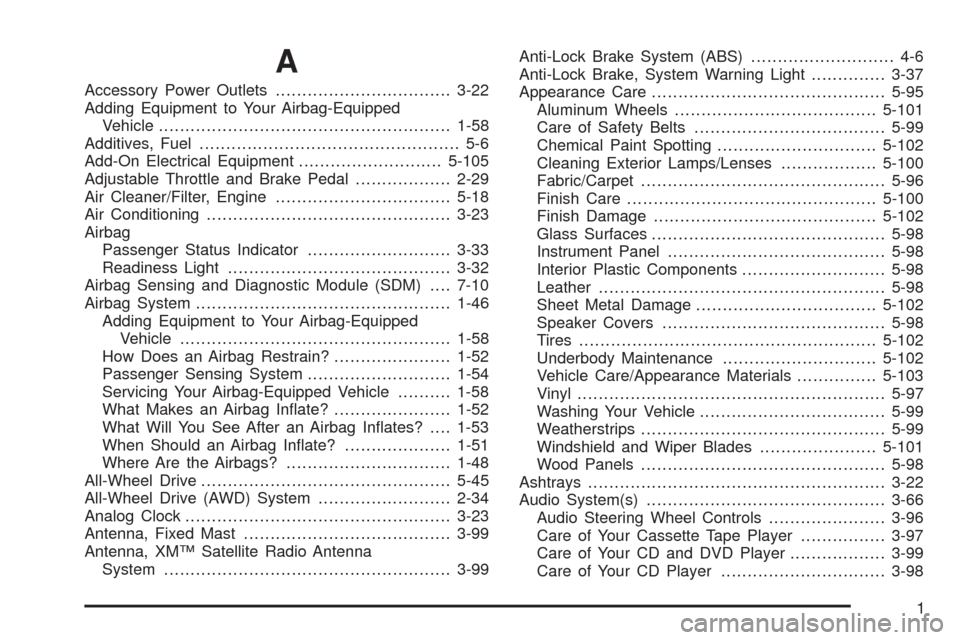
A
Accessory Power Outlets.................................3-22
Adding Equipment to Your Airbag-Equipped
Vehicle.......................................................1-58
Additives, Fuel................................................. 5-6
Add-On Electrical Equipment...........................5-105
Adjustable Throttle and Brake Pedal..................2-29
Air Cleaner/Filter, Engine.................................5-18
Air Conditioning..............................................3-23
Airbag
Passenger Status Indicator...........................3-33
Readiness Light..........................................3-32
Airbag Sensing and Diagnostic Module (SDM)....7-10
Airbag System................................................1-46
Adding Equipment to Your Airbag-Equipped
Vehicle...................................................1-58
How Does an Airbag Restrain?......................1-52
Passenger Sensing System...........................1-54
Servicing Your Airbag-Equipped Vehicle..........1-58
What Makes an Airbag In�ate?......................1-52
What Will You See After an Airbag In�ates?....1-53
When Should an Airbag In�ate?....................1-51
Where Are the Airbags?...............................1-48
All-Wheel Drive...............................................5-45
All-Wheel Drive (AWD) System.........................2-34
Analog Clock..................................................3-23
Antenna, Fixed Mast.......................................3-99
Antenna, XM™ Satellite Radio Antenna
System......................................................3-99Anti-Lock Brake System (ABS)........................... 4-6
Anti-Lock Brake, System Warning Light..............3-37
Appearance Care............................................5-95
Aluminum Wheels......................................5-101
Care of Safety Belts....................................5-99
Chemical Paint Spotting..............................5-102
Cleaning Exterior Lamps/Lenses..................5-100
Fabric/Carpet..............................................5-96
Finish Care...............................................5-100
Finish Damage..........................................5-102
Glass Surfaces............................................5-98
Instrument Panel.........................................5-98
Interior Plastic Components...........................5-98
Leather......................................................5-98
Sheet Metal Damage..................................5-102
Speaker Covers..........................................5-98
Tires........................................................5-102
Underbody Maintenance.............................5-102
Vehicle Care/Appearance Materials...............5-103
Vinyl..........................................................5-97
Washing Your Vehicle...................................5-99
Weatherstrips..............................................5-99
Windshield and Wiper Blades......................5-101
Wood Panels..............................................5-98
Ashtrays........................................................3-22
Audio System(s).............................................3-66
Audio Steering Wheel Controls......................3-96
Care of Your Cassette Tape Player................3-97
Care of Your CD and DVD Player..................3-99
Care of Your CD Player...............................3-98
1
Page 457 of 460
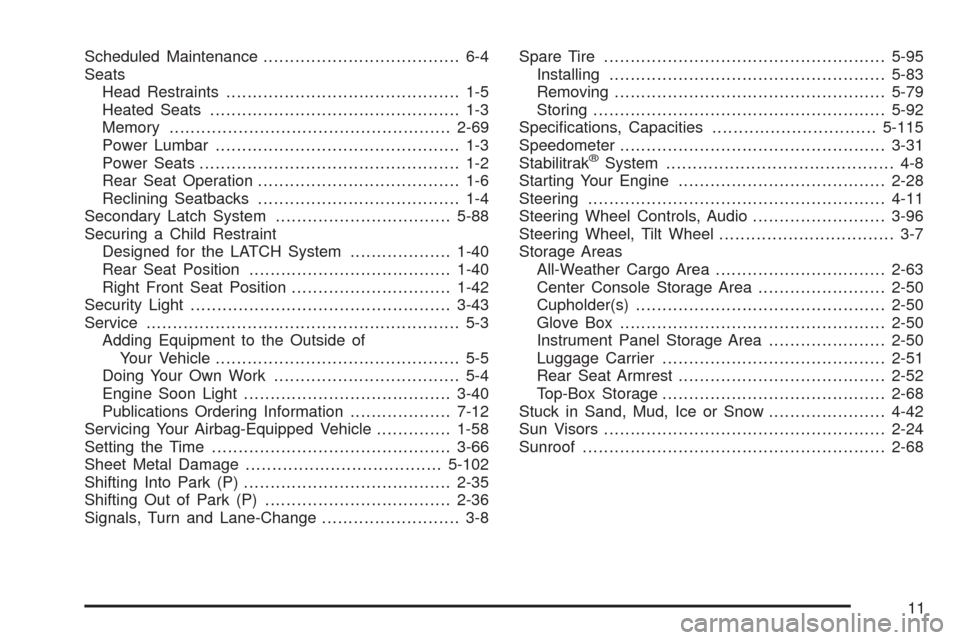
Scheduled Maintenance..................................... 6-4
Seats
Head Restraints............................................ 1-5
Heated Seats............................................... 1-3
Memory.....................................................2-69
Power Lumbar.............................................. 1-3
Power Seats................................................. 1-2
Rear Seat Operation...................................... 1-6
Reclining Seatbacks...................................... 1-4
Secondary Latch System.................................5-88
Securing a Child Restraint
Designed for the LATCH System...................1-40
Rear Seat Position......................................1-40
Right Front Seat Position..............................1-42
Security Light.................................................3-43
Service........................................................... 5-3
Adding Equipment to the Outside of
Your Vehicle.............................................. 5-5
Doing Your Own Work................................... 5-4
Engine Soon Light.......................................3-40
Publications Ordering Information...................7-12
Servicing Your Airbag-Equipped Vehicle..............1-58
Setting the Time.............................................3-66
Sheet Metal Damage.....................................5-102
Shifting Into Park (P).......................................2-35
Shifting Out of Park (P)...................................2-36
Signals, Turn and Lane-Change.......................... 3-8Spare Tire.....................................................5-95
Installing....................................................5-83
Removing...................................................5-79
Storing.......................................................5-92
Speci�cations, Capacities...............................5-115
Speedometer..................................................3-31
Stabilitrak
®System........................................... 4-8
Starting Your Engine.......................................2-28
Steering........................................................4-11
Steering Wheel Controls, Audio.........................3-96
Steering Wheel, Tilt Wheel................................. 3-7
Storage Areas
All-Weather Cargo Area................................2-63
Center Console Storage Area........................2-50
Cupholder(s)...............................................2-50
Glove Box..................................................2-50
Instrument Panel Storage Area......................2-50
Luggage Carrier..........................................2-51
Rear Seat Armrest.......................................2-52
Top-Box Storage..........................................2-68
Stuck in Sand, Mud, Ice or Snow......................4-42
Sun Visors.....................................................2-24
Sunroof.........................................................2-68
11